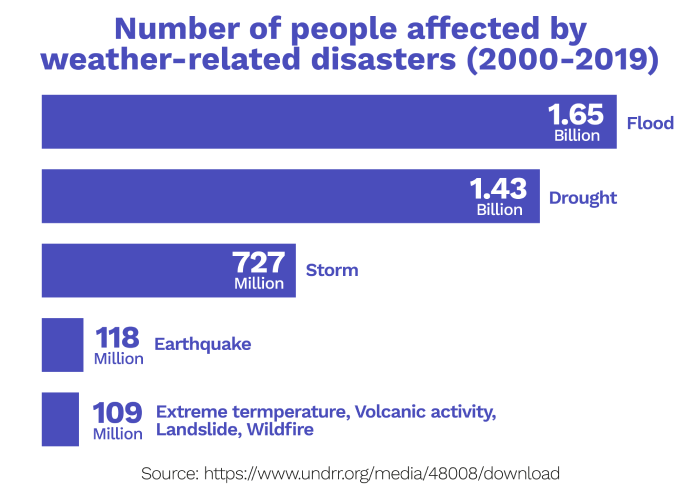The majority of the world’s population will live in cities by 2050, and, therefore, be particularly at risk during heatwaves .
.
Without clean water to drink, people may also get dehydrated, which can cause headaches, dizziness, tiredness and damage to the body
 . Drinking unclean water leads to health problems like diarrhoea, which causes 4% of all deaths worldwide
. Drinking unclean water leads to health problems like diarrhoea, which causes 4% of all deaths worldwide
 .
.
Some insects that spread diseases survive better in warmer climates
 . For example, malaria is a disease carried by mosquitoes that causes over 400,000 deaths every year
. For example, malaria is a disease carried by mosquitoes that causes over 400,000 deaths every year
 . Today, most malaria infections occur in sub-Saharan Africa
. Today, most malaria infections occur in sub-Saharan Africa . Mosquitoes prefer warm, moist environments, so they may move towards new places as they get hotter. This will put different groups of people at risk of the deadly disease
. Mosquitoes prefer warm, moist environments, so they may move towards new places as they get hotter. This will put different groups of people at risk of the deadly disease

 .
.
As well as insects, many bacteria cause diseases in humans . Bacteria grow faster if they are warmer
. Bacteria grow faster if they are warmer
 . In fact, temperatures also affect their ability to exchange DNA
. In fact, temperatures also affect their ability to exchange DNA

 . In a warmer climate, bacteria exchange DNA faster, including DNA that allows them to become resistant to antibiotics
. In a warmer climate, bacteria exchange DNA faster, including DNA that allows them to become resistant to antibiotics . More antibiotic resistance would make it impossible to treat many infections
. More antibiotic resistance would make it impossible to treat many infections .
.
Another thing that can affect our physical health is air pollution. Air pollution can worsen breathing conditions such as asthma , as well as increasing lung cancer, strokes and heart disease
, as well as increasing lung cancer, strokes and heart disease . There’s also evidence that air pollution can make infection by air-borne viruses worse
. There’s also evidence that air pollution can make infection by air-borne viruses worse
 . Global warming affects air pollution because of things like increased wildfires and the changes to gas concentrations at ground level which occur in hotter temperatures
. Global warming affects air pollution because of things like increased wildfires and the changes to gas concentrations at ground level which occur in hotter temperatures


 .
.
If no changes are made to stop this, air pollution could cause 1,000-4,300 more deaths per year in the USA alone by 2050 .
.
Injustice
You might have noticed that the impacts of climate change are going to affect some people and places more than others. We already live in an unequal world, and climate change is set to make it even less equal.
Imagine if someone else broke a bunch of glasses, but left the sharp pieces of glass all over your floor. Even worse, while they can wear shoes to protect their feet, you don’t have any!
Well, it’s like this with climate change: the worst damage is predicted to hit people who are least responsible for causing it! In other words, the countries that produce lower greenhouse gas emissions will be the most affected. On top of that, these places often have fewer resources to help protect themselves from these impacts.
Without urgent action, climate change impacts could push an additional 100 million people into poverty by 2030 . Over 99 percent of deaths already thought to have happened because of climate change occur in developing countries – and children make up over 80 percent of those deaths
. Over 99 percent of deaths already thought to have happened because of climate change occur in developing countries – and children make up over 80 percent of those deaths .
.
It is predicted that by 2050, 1 in every 45 people in the world will have had to leave their homes due to climate change ! People may migrate in this way to escape drought, flooding and other extreme weather events
! People may migrate in this way to escape drought, flooding and other extreme weather events

 . Sea level rise is already forcing people to move
. Sea level rise is already forcing people to move and if temperatures rise by 3°C, coastal cities like Miami and Shanghai may go completely underwater
and if temperatures rise by 3°C, coastal cities like Miami and Shanghai may go completely underwater !
!
All these consequences are likely to cause more conflict between different communities and countries . Poverty, lack of resources and migration can all lead to conflict, and each of these is expected to worsen with climate change
. Poverty, lack of resources and migration can all lead to conflict, and each of these is expected to worsen with climate change .
.
Conclusion
Climate change will affect how people live and die. From extreme weather disasters to our water and food supply

 , these consequences need to be taken seriously.
, these consequences need to be taken seriously.
Next Chapter.
, and makes up about 60% of your body weight
. Yet, 2.2 billion people don’t have access to safe drinking water
!
. As well as direct deaths, floods can destroy buildings, cause landslides and worsen the effects of diseases which spread through water
.
.






